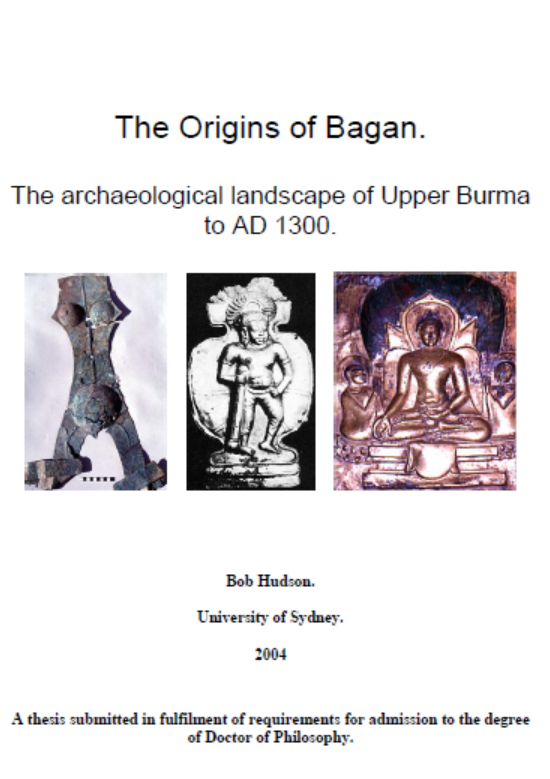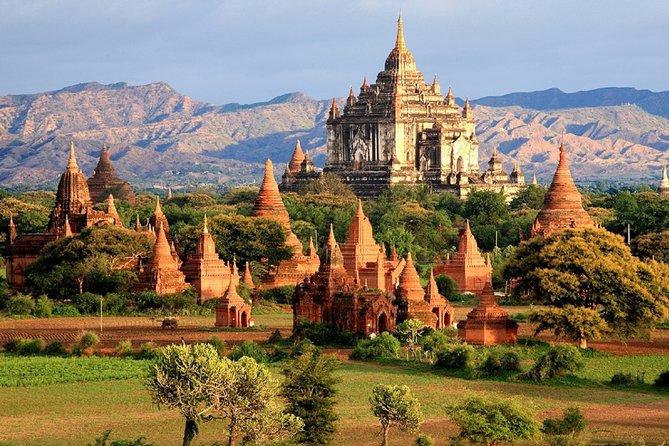The Origins of Bagan: The archaeological landscape of Upper Burma to AD 1300
by Bob Hudson
Origins and early development of the Kingdom of Bagan (Pagan).

- Format
- on-demand books
- Publisher
- Ph.D. thesis submitted to University of Sydney
- Edition
- Self-edition
- Published
- 2004
- Author
- Bob Hudson
- Pages
- 331
- Language
- English
With its more than 3,400 temples, the breathtaking site of Bagan has often been compared to Angkor, and in fact the Kingdom-Empire centered in this polity reached its peak between the 11th and 14th centuries, approximately at the same time that the Khmer Empire.
Studying prehistoric archeological findings as well as inscriptions and Chinese and Burmese chronicles, the author remarks that the city was “first mentioned in a Cham inscription of 1050″. He thoroughly discusses what historian Michael Aung-Thwin has called the “Mon paradigm”, the widely accepted notion that Bagan’s expansion was essentially based on the “inflow of Mon culture”.
The insights on Bagan’s earliest most influential sovereign, King Anawratha (1017−1059 CE) are particulary fascinating: the youngest of royal siblings Kyizo (986−992 CE) and Sokkate, Anawratha, according to various sources, “gained power after he mustered an army at Mount Popa and marched on Bagan, killing Sokkate with a lance supplied by the god Sakra (Indra). A magically-born princess from Vesali was sent to be Anawratha’s queen, and she gave birth to Kyanzittha, who was eventually taken into his father’s court following a series of dramatic incidents relating to his birth and to Anawratha’s fear of being overthrown. Kyanzittha became one of Anawratha’s generals along with three other heroes, who came from Myin Mu (upriver near the mouth of the Mu River), Nyaung‑u (the village on the northern end of the Bagan monument zone) and Mount Popa. The home territories of these heroes may reflect the significance of the relationship of Bagan’s periphery to the administrative centre.”
After achieving several (real or legendary) prowesses, such as the conquest of the Kingdom of Thaton, and the acquisition of religious relics, including a magic tooth from “the Tarop country of the kingdom of Gandhala” (Yunnan) which he enshrined in the Shwezigon pagoda in Bagan, and a tooth relic from Ceylon which magically replicated itself four times at Bagan, he demarcated and fortified the city.
Adds the author: ‘When a host of Khmer warriors marched on Ussa Pegu, Anawratha sent Kyanzittha and the other heroes south to fight them off. As the heroes returned with a princess for Anawratha, Kyanzittha lay with her, and was exiled. The princess suffered no blame, and became Anawratha’s queen. Anawratha took his court on a circuit of his domains, building pagodas, dams and other irrigation works and 43 frontier towns and fortresses, the northernmost of which was Kaungsin, on the upper Ayeyarwady, close to the current border with Yunnan. As he returned to his palace, he was killed by a wild buffalo which had been an enemy of his in a previous life.’
Bob Hudson’s Ph.D. thesis can be requested by email email hidden; JavaScript is required.

Bagan and surrounding hills (Photo Viator)
Tags: Pyu, Mon, Burma, Bagan, archaeology, Yunnan, Burmese chronicles
About the Author

Bob Hudson
A doctor in archaeology from University of Sydney under the supervision of Pr. Roland Fletcher, academic researcher Bob Hudson has been studying early civilizations and urban systems in Myanmar (Burma), in particular the Bagan temple complex (some 3,400 buildings recensed so far) and the ancient Pyu language.
An adviser to the Mrauk‑U UNESCO World Heritage application, and to the 2014 UNESCO inscription of Bagan and Pyu Ancient Cities, Dr. Bob Hudson is a visiting fellow in Archaeology at Yangon University, Myanmar, a visiting lecturer at the Myanmar Department of Archaeology Field School at Pyay (the site of the Pyu city of Sriksetra), and a patron of the Myanmar Archaeology Association.
